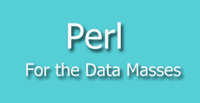
Perl Programming for the Data MassesEver heard of the Human Genome Project? Then even if you know nothing about the Perl language, you know something about its applications. One of its successes has been to manage huge amounts of genetic data.  Perl is not an acronym, but has sometimes been referred to as the Practical Extraction and Report Language. Its development goes back a long time: to 1986. Larry Hall, then a developer at Unisys, invented it while trying to synchronize information and generate reports. C was good for some of his programming needs while Unix shells (Learn about UNIX) were handy for others. And so Hall needed something that would glue them together. Over time, Perl evolved to include components of many computer languages, not just C and Unix. Hall has referred to it as a "postmodern computer language" because it draws its wisdom from so many sources without necessarily giving allegiance to any. Hall's language was briefly known as RN; it was Perl, though, by 1987 when Version 1.0 was introduced. 2.0 followed only a year later. Version 2 introduced many new features including wait and sort operators and support for recursive subroutine calls. 1989 brought version 3.0 and distribution under a GNU license. Perl achieved fame -- and, yes, a bit of infamy, while it was still quite a young computer language. Yahoo relied on it to meet its goals. So did many hackers. Perl 5 represented a major rewrite. Currently Perl 5 and Perl 6 are both in usage; they are considered separate languages and are under simultaneous development. Versions earlier than 5 have not been supported or used for a long time due to security issues. Yahoo relied on Perl to meet its goals. So did many hackers. ~ Fame and Infamy
Perl is now offered free under a license even more generous than GNU. It may have begun as a one man operation, but it’s now the work of thousands. The Comprehensive Perl Archive Network, or CPAN as it is commonly called, includes 114,498 modules written by more than 10,000 individuals. A number of other languages contain at least a pearl of Perl. Perl eventually spawned other scripting languages like PHP (Learn about the PHP Programming Language). Uses of PerlPerl is frequently described as a glue because it can get incompatible systems communicating. One common application of the language is to write bits of code that transfer data from one format to another. Perl is also used to make quick batch modifications and to create Graphical User Interfaces. Perl is used extensively in health informatics. It is a go-to language for creating programs that do health care billing. It is also used in programs that manage sensitive health care data. Bioinformatics, meanwhile, has been Perl territory for over a decade. Perl is used in in a variety of other industries including the ground segment of space exploration. The NASA Technical Reports Server relies on PERL. Perl is used extensively in health informatics.
When is Perl not the best choice? If you are a website administrator or developer with more basic tasks like creating guest books and forums, you may find that it's more complicated than you need. Perl is not as simple as some scripting languages -- either to learn or to read. Performance varies by task. There is more overhead on some tasks than there is with compiled languages. Learning PerlInterested in learning more about Perl? There are a lot of “authority sites”; they appear separate but many are in some way affiliated with the Perl Foundation. You can begin learning Perl online. The official Perl 5 site has a subdomain of learning resources. You can write your first program – Hello World – as soon as you’ve downloaded Perl. You won’t find in-depth resources here, though. On the related site, Perl Monks, you'll find a lot of tutorials, written by aficionados and organized into categories like database programming and user interfaces. You'll find forums and other resources, too. You can also opt for a book. Programming Perl, put out by O'Reilly Media, is a mainstay. There is also a free online book, Beginning Perl, at the site of Perl.org. To stay current on PERL, you can join a Perl Mongers group. (Check ou...How to Become a Perl Developer) |

